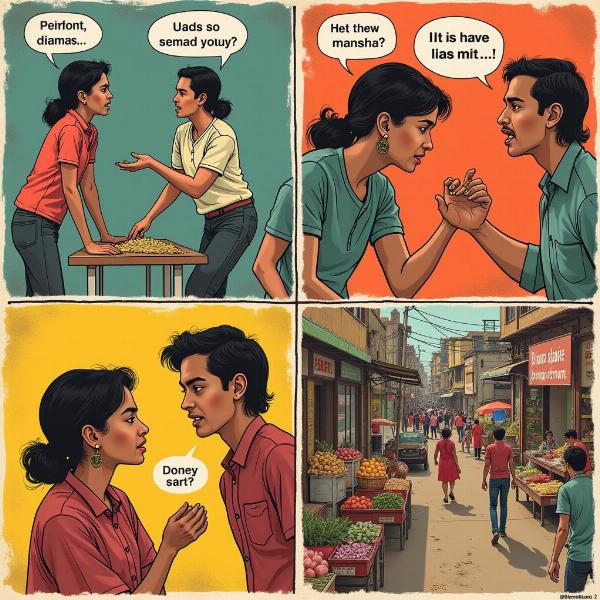Theatrics meaning in Hindi encompasses a wide range of terms, reflecting the rich tradition of dramatic arts and expressive communication in Indian culture. Whether you’re looking for a direct translation of “theatrics” or seeking to understand the various nuances of dramatic expression in Hindi, this article will provide a comprehensive overview. We’ll explore common Hindi words used to describe theatrics, their cultural context, and how they’re used in everyday conversations.
Exploring the Hindi Equivalents of “Theatrics”
Several Hindi words capture the essence of “theatrics,” each with its own subtle connotations. “नाटकीयता” (naatakiyata) is a direct translation, referring to the quality of being theatrical or dramatic. However, other words like “ड्रामा” (drama), “तमाशा” (tamasha), and “मिथ्या नाटक” (mithya natak – false drama) can also be used depending on the specific context. Understanding these nuances is crucial for accurately conveying the intended meaning.
The Cultural Context of Theatrics in India
Theatrical expression is deeply ingrained in Indian culture, with a history spanning centuries. From ancient Sanskrit dramas to contemporary Bollywood films, theatrics play a vital role in storytelling, entertainment, and even religious rituals. This rich tradition influences the way Hindi speakers perceive and express dramatic emotions.
Common Usage and Examples
“Drama” (ड्रामा) is often used colloquially to describe exaggerated or attention-seeking behavior. For instance, “बहुत ड्रामा कर रहा है” (bahut drama kar raha hai) translates to “He’s being very dramatic.” “Tamasha” (तमाशा), on the other hand, often implies a spectacle or a noisy, chaotic scene.
 Drama and Tamasha in Hindi
Drama and Tamasha in Hindi
Theatrics in Different Contexts
The meaning of “theatrics” can also vary based on the context. In the realm of performing arts, it refers to the techniques and elements used to create a dramatic performance. In everyday conversations, it might describe someone’s exaggerated behavior or a dramatic situation.
Understanding the Nuances of “Rang” (रंग)
“Rang” (रंग) in Hindi primarily means “color,” but it can also be used metaphorically to describe the vibrancy and emotional depth of a performance or a situation. For example, “रंग में आना” (rang mein aana) means “to get into the spirit” or “to become immersed in the emotion.”
Conclusion: A Multifaceted Term
“Theatrics meaning in Hindi” is not just a simple translation, but a journey into the rich tapestry of Indian culture and its expressive language. By understanding the various nuances of words like “naatakiyata,” “drama,” “tamasha,” and “rang,” we can appreciate the depth and complexity of dramatic expression in Hindi.
FAQ
-
What is the most common Hindi word for “theatrics”? The most direct translation is “naatakiyata” (नाटकीयता).
-
How is “drama” used in everyday Hindi conversations? It often describes exaggerated or attention-seeking behavior.
-
What does “tamasha” imply? It typically suggests a spectacle or a chaotic, noisy scene.
-
What is the metaphorical meaning of “rang”? It can refer to the vibrancy and emotional depth of a performance or situation.
-
How does Indian culture influence the understanding of theatrics? The rich history of theatrical arts in India shapes how Hindi speakers perceive and express dramatic emotions.
You Might Also Be Interested In:
- overdramatic meaning in hindi
- drama in hindi meaning
- siyappa meaning in hindi
- over dramatic meaning in hindi
- rang in hindi meaning
Meaning-Hindi.in is your premier resource for Hindi translation and language services. We specialize in Business & Commercial, Legal & Certified, Technical & User Manual, Website & Localization, Educational & Academic, Express & Urgent, and Specialized translations. Need accurate and culturally sensitive translations? Contact us today! Email: [email protected], Phone: +91 11-4502-7584. Meaning-Hindi.in offers a wide array of translation solutions to bridge the language gap and connect you with your target audience effectively.